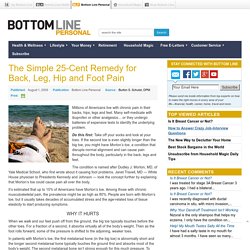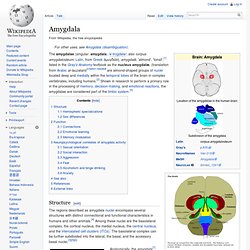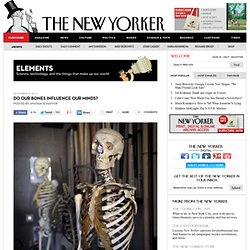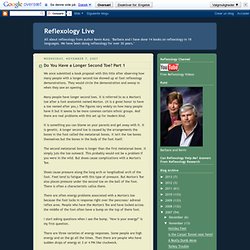

The Simple 25-Cent Remedy for Back, Leg, Hip and Foot Pain. Millions of Americans live with chronic pain in their backs, hips, legs and feet.

Many self-medicate with ibuprofen or other analgesics… or they undergo batteries of expensive tests to identify the underlying problem. Do this first: Take off your socks and look at your toes. If the second toe is even slightly longer than the big toe, you might have Morton’s toe, a condition that disrupts normal alignment and can cause pain throughout the body, particularly in the back, legs and feet.
The condition is named after Dudley J. Morton, MD, of Yale Medical School, who first wrote about it causing foot problems. It’s estimated that up to 15% of Americans have Morton’s toe. When we walk and our feet push off from the ground, the big toe typically touches before the other toes. MotionSavvy uses gesture recognition to give sign language a voice. Amygdala. Human brain in the coronal orientation.

Amygdalae are shown in dark red. Structure[edit] MRI coronal view of the left amygdala Anatomically, the amygdala[7] and more particularly, its central and medial nuclei,[8] have sometimes been classified as a part of the basal ganglia. Hemispheric specializations[edit] There are functional differences between the right and left amygdala. Sex differences[edit] The amygdala is one of the most well understood brain regions with regard to differences between the sexes. In addition to size, other differences between men and women exist with regards to the amygdala.
The right amygdala is also linked with taking action as well as being linked to negative emotions,[15] which may help explain why males tend to respond to emotionally stressful stimuli physically. Function[edit] Connections[edit] The cortical nucleus is involved in the sense of smell and pheromone-processing. Emotional learning[edit] Memory modulation[edit]
Do Our Bones Influence Our Minds? In the mid-nineteen-nineties, a young French geneticist and physician named Gerard Karsenty became curious about a mysterious protein, called osteocalcin, that is found at high concentrations in the skeleton.

He worked with mice that had been engineered to lack the substance, expecting to find problems with their bones. But their skeletons appeared essentially normal, he says, a result that left him “deeply depressed.” The mice did have issues, though. Their abdomens were fatty, they had trouble breeding, and they were “stupid,” meaning “they never rebelled or tried to bite or escape,” said Karsenty, now fifty-nine years old and the chair of the department of genetics and development at Columbia University Medical Center. He has studied osteocalcin for almost two decades. The finding represents new ground in how researchers view the skeleton: not only do bones provide structural support and serve as a repository for calcium and phosphate, they issue commands to far-flung cells.
The Deaf Resource Library. How to Tell If You are Hypothyroid. Do You Have a Longer Second Toe? Part 1. We once submitted a book proposal with this title after observing how many people with a longer second toe showed up at foot reflexology demonstrations.

They would circle the demonstration and swoop in when they saw an opening. Many people have longer second toes. It is referred to as a Morton's toe after a foot anatomist named Morton. (It is a great honor to have a toe named after you,) The figures vary widely on how many people have it but it seems to be more common certain ethnic groups. And there are real problems with this set up for modern kind. It is something you can blame on your parents and get away with it. The second metatarsal bone is longer than the first metatarsal bone. Shoes cause pressure along the long arch or longitudinal arch of the foot.
There are often energy problems associated with a Morton's toe because the foot locks in response right over the pancreas/ adrenal reflex area. I start asking questions when I see the bump. Kevin Kunz. Morton's Toe: One Little Bone, One Big Problem. The human body contains many wonderful things.

Most of them have been handed down genetically, from parent to child, and there is little we can do to change them. One such trait is called Morton’s Toe. Only about 10 percent of the world population has this attribute, where the second toe appears longer than the first. About 80 percent of those with Morton’s Toe suffer from chronic pain. Much of it is thought to derive from this relatively rare foot configuration. Want to earn continuing education credit for this article? The human body is indeed a marvelous, well-coordinated system of bones, muscles, organs, glands and a myriad of other wonders.
While doing research on another article, I discovered something about myself, that for more than 50 years I had always thought to be normal – only now to find out that by some it is labeled a “deformity.” What Is Morton’s Toe? Morton’s Toe is not to be confused with Morton’s Neuroma, a condition named for Thomas C. A Cause of Many Ills Dr.